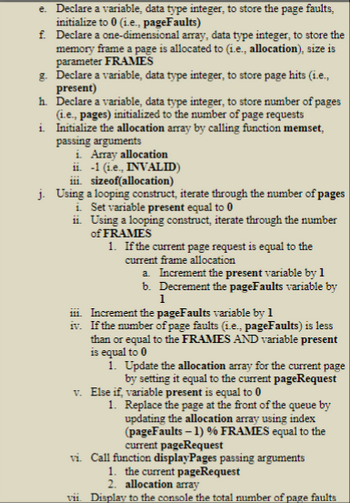
Database System Concepts
7th Edition
ISBN: 9780078022159
Author: Abraham Silberschatz Professor, Henry F. Korth, S. Sudarshan
Publisher: McGraw-Hill Education
expand_more
expand_more
format_list_bulleted
Question
How would I create this function using C?

Transcribed Image Text:e. Declare a variable, data type integer, to store the page faults,
initialize to 0 (i.e., pageFaults)
f.
Declare a one-dimensional array, data type integer, to store the
memory frame a page is allocated to (i.e., allocation), size is
parameter FRAMES
g. Declare a variable, data type integer, to store page hits (i.e.,
present)
h. Declare a variable, data type integer, to store number of pages
(i.e., pages) initialized to the number of page requests
Initialize the allocation array by calling function memset,
passing arguments
i.
i. Array allocation
ii. -1 (i.e., INVALID)
iii. sizeof(allocation)
j. Using a looping construct, iterate through the number of pages
i. Set variable present equal to 0
ii. Using a looping construct, iterate through the number
of FRAMES
1. If the current page request is equal to the
current frame allocation
a. Increment the present variable by 1
b. Decrement the pageFaults variable by
1
iii. Increment the pageFaults variable by 1
iv.
If the number of page faults (i.e., pageFaults) is less
than or equal to the FRAMES AND variable present
is equal to 0
1. Update the allocation array for the current page
by setting it equal to the current pageRequest
v. Else if, variable present is equal to 0
1. Replace the page at the front of the queue by
updating the allocation array using index
(pageFaults - 1) % FRAMES equal to the
current pageRequest
vi. Call function displayPages passing arguments
1. the current pageRequest
2. allocation array
vii. Display to the console the total number of page faults

Transcribed Image Text:fifo
7. Write function fifo to do the following
a. Return type void
b.
c.
d.
Empty parameter list
Write a series of printf statements to display the algorithm
name and the output header
Declare a one-dimensional array, data type integer, to store the
page requests (i.e., pageRequests) initialized to data set 4, 1,
2, 4, 2, 5, 1, 3, 6
Expert Solution
This question has been solved!
Explore an expertly crafted, step-by-step solution for a thorough understanding of key concepts.
Step by stepSolved in 3 steps

Knowledge Booster
Learn more about
Need a deep-dive on the concept behind this application? Look no further. Learn more about this topic, computer-science and related others by exploring similar questions and additional content below.Similar questions
- What are the potential risks of creating and using recursive function objects, and how can they be mitigated?arrow_forwardGive an example of function composition. Explain how it work.arrow_forwardHaskell how to put the numbers for this function in ghci f g [] = []f g (x:xs) = g x : f g xsarrow_forward
- Solve the Below Program in C language. Write a program in C to show the simple structure of a function. Expected Output : The total is : 11arrow_forward*In C program, what is wrong with the following function? int integer_add( int x, int y, int z ) { int sum; sum = x + y + z: return sum; }arrow_forwardPlease solve it in C languagearrow_forward
- 1. Write a c++ code that takes two integer numbers as inputs, then adds them using a function called add(x,y), then subtracts them using a function called subtract(x,y), and outputs the results in an understandable way.arrow_forwardHow can I calculate maximum and minimum of a function in python?arrow_forwardWhat are the most prevalent types of C++ functions? With the help of a program, define three typical types of functions in C++.arrow_forward
arrow_back_ios
arrow_forward_ios
Recommended textbooks for you
 Database System ConceptsComputer ScienceISBN:9780078022159Author:Abraham Silberschatz Professor, Henry F. Korth, S. SudarshanPublisher:McGraw-Hill Education
Database System ConceptsComputer ScienceISBN:9780078022159Author:Abraham Silberschatz Professor, Henry F. Korth, S. SudarshanPublisher:McGraw-Hill Education Starting Out with Python (4th Edition)Computer ScienceISBN:9780134444321Author:Tony GaddisPublisher:PEARSON
Starting Out with Python (4th Edition)Computer ScienceISBN:9780134444321Author:Tony GaddisPublisher:PEARSON Digital Fundamentals (11th Edition)Computer ScienceISBN:9780132737968Author:Thomas L. FloydPublisher:PEARSON
Digital Fundamentals (11th Edition)Computer ScienceISBN:9780132737968Author:Thomas L. FloydPublisher:PEARSON C How to Program (8th Edition)Computer ScienceISBN:9780133976892Author:Paul J. Deitel, Harvey DeitelPublisher:PEARSON
C How to Program (8th Edition)Computer ScienceISBN:9780133976892Author:Paul J. Deitel, Harvey DeitelPublisher:PEARSON Database Systems: Design, Implementation, & Manag...Computer ScienceISBN:9781337627900Author:Carlos Coronel, Steven MorrisPublisher:Cengage Learning
Database Systems: Design, Implementation, & Manag...Computer ScienceISBN:9781337627900Author:Carlos Coronel, Steven MorrisPublisher:Cengage Learning Programmable Logic ControllersComputer ScienceISBN:9780073373843Author:Frank D. PetruzellaPublisher:McGraw-Hill Education
Programmable Logic ControllersComputer ScienceISBN:9780073373843Author:Frank D. PetruzellaPublisher:McGraw-Hill Education

Database System Concepts
Computer Science
ISBN:9780078022159
Author:Abraham Silberschatz Professor, Henry F. Korth, S. Sudarshan
Publisher:McGraw-Hill Education

Starting Out with Python (4th Edition)
Computer Science
ISBN:9780134444321
Author:Tony Gaddis
Publisher:PEARSON

Digital Fundamentals (11th Edition)
Computer Science
ISBN:9780132737968
Author:Thomas L. Floyd
Publisher:PEARSON

C How to Program (8th Edition)
Computer Science
ISBN:9780133976892
Author:Paul J. Deitel, Harvey Deitel
Publisher:PEARSON

Database Systems: Design, Implementation, & Manag...
Computer Science
ISBN:9781337627900
Author:Carlos Coronel, Steven Morris
Publisher:Cengage Learning

Programmable Logic Controllers
Computer Science
ISBN:9780073373843
Author:Frank D. Petruzella
Publisher:McGraw-Hill Education